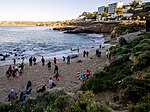Red Rest and Red Roost Cottages
American Craftsman architectureAmerican Craftsman architecture in CaliforniaBungalow architectureCulture of San DiegoHistoric American Buildings Survey ... and 5 more
Historic preservation in the United StatesHistory of San DiegoLa Jolla, San DiegoNational Register of Historic Places in CaliforniaNational Register of Historic Places in San Diego

The Red Roost and The Red Rest, built in 1894, are historic beach cottages overlooking La Jolla Cove in La Jolla, San Diego, California. At one time, they were outstanding examples of the first-generation California bungalow. Their placement on the National Register of Historic Places in 1976 has not prevented serious deterioration due to neglect. The La Jolla Park Coastal Historic District, listed on the National Register of Historic Places on May 9, 2024, includes The Red Roost and the Red Rest as contributing resources.
Excerpt from the Wikipedia article Red Rest and Red Roost Cottages (License: CC BY-SA 3.0, Authors, Images).Red Rest and Red Roost Cottages
Coast Boulevard, San Diego La Jolla
Geographical coordinates (GPS) Address Nearby Places Show on map
Geographical coordinates (GPS)
| Latitude | Longitude |
|---|---|
| N 32.849722222222 ° | E -117.2725 ° |
Address
Coast Boulevard 1187
92037 San Diego, La Jolla
California, United States
Open on Google Maps










